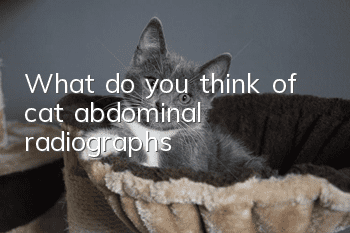What do you think of cat abdominal radiographs?

For cats, the abdominal cavity is a huge area, which contains most of the systems and organs of the body. Therefore, the examination of the abdominal cavity is not just as simple as palpation and auscultation. Radiographic examination is helpful for better To judge the disease and view the development of the disease in an intuitive way.
1. Volume changes
Changes in volume mainly manifest as an increase or decrease in the size of internal organs compared to normal. The reasons for the increase in organ size may be swelling, hyperplasia, and hypertrophy of tissues and organs, and the occurrence of tumors, cysts, hematomas, abscesses, emphysema, or fluid accumulation in the organs. This will make the diseased organ larger than normal, sometimes several times larger, causing changes in the position or shape of tissues or organs adjacent to the diseased organ. The reduction in size may be due to congenital underdevelopment of the organs or atrophy of the organs due to disease.
2. Changes in location
Changes in position indicate abnormal displacement of internal organs. Except for the jejunum, which is relatively free, the positions of other organs in the abdominal cavity are relatively fixed. Most of the causes of displacement are due to the movement of lesions in adjacent tissues and organs. For example, retrograde gastric displacement is often caused by liver enlargement or the movement of liver tumors or cysts. On the contrary, gastric forward displacement may be caused by liver atrophy, diaphragm rupture, or enlargement of organs behind the stomach such as the spleen or pancreas.
3. Changes in morphological outline
Changes in morphological contours are manifested as deformations of internal organs. Any deformation beyond the physiological range of luminal organs such as the stomach, intestines, bladder, uterus, and parenchymal organs such as liver, spleen, and kidneys is a sign of disease. Types of deformation include changes in geometry, changes in surface shape, and changes in the morphology of the mucosa of hollow organs. For example, after hepatomegaly, the posterior edge of the liver becomes blunt and rounded; in cirrhosis and liver tumors, the surface of the liver is irregular; in gastric ulcers, the direct sign is the niche shadow during barium feeding; in bladder tumors, the result of positive cystography is Mucosal filling defect.
4. Changes in density
Changes in abdominal density are manifested as increased density or decreased density, and can be manifested as widespread or localized density changes. Extensive increased density is common in peritoneal effusion, peritonitis, and peritoneal tumors. X-ray films show extensive increased density of soft tissue shadows, and the outline of intra-abdominal organs is unclear. Localized increased density in the abdomen is common in tumors or enlargements of abdominal organs, and appears as localized high-density soft tissue shadows on X-rays. If there are calcifications (calcification of abdominal lymph nodes) or organ stones (gallstones, kidney stones or bladder stones) in the abdominal cavity, they will appear as high-density foreign body shadows. Low-density shadows in the abdomen can be seen in gastric and intestinal gas, and pneumoperitoneum caused by various reasons. It should be noted that under normal circumstances, some gas remains more or less in the digestive tract, which also appears as a low-density shadow. In actual work, it should be compared with pathology.Sexual shadow to identify.
5. Things to note
1. During abdominal X-ray examination, multiple positions should be used and different imaging techniques should be used, otherwise the diagnosis may be missed. For example, if the foreign body in the stomach is highly radiolucent, the image of the foreign body may be obscured by the food and gas in the stomach during single-position photography.
2. Pay attention to the differential diagnosis of different diseases, such as the identification of abdominal masses and ascites. Abdominal masses are space-occupying X-ray images, while ascites is a high-density homogeneous image, with intestinal and other abdominal organs floating in it.
3. Pay attention to the normal position of the abdominal nipple, which can easily be misdiagnosed as ureteral stones.
4. Functional disorders of tissues and organs are difficult to show in plain X-ray films. It is often necessary to use contrast techniques and ultrasound imaging to show certain details of the abdominal organs.
- Why do cats often vomit cat food?
- Why do cats like to step on their breasts?
- What is the full name of British short name?
- How to give birth to an American shorthair cat
- What to do if a cat is born prematurely
- Scratched by an unvaccinated cat
- Does the cat recognize its home and owner?
- Can blue cats eat rice?
- Are blue tabby cats hybrid cats?
- Never cook meat for cats



